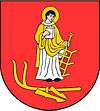Sochaczew
Sochaczew [sɔˈxat͡ʂɛf] is a city in central Poland, with 38,300 inhabitants (2004). In the Masovian Voivodeship (since 1999), formerly in Skierniewice Voivodeship (1975–1998). It is the capital of Sochaczew County.
Sochaczew | |
|---|---|
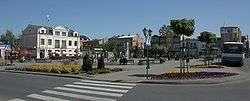 | |
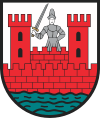 Coat of arms | |
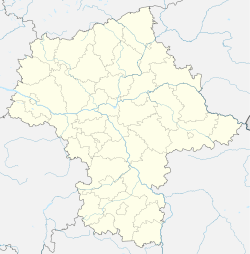 Sochaczew  Sochaczew | |
| Coordinates: 52°14′N 20°14′E | |
| Country | |
| Voivodeship | |
| County | Sochaczew County |
| Gmina | Sochaczew (urban gmina) |
| Town rights | 1368 |
| Government | |
| • Mayor | Piotr Osiecki |
| Area | |
| • Total | 26.13 km2 (10.09 sq mi) |
| Elevation | 81 m (266 ft) |
| Population (2010) | |
| • Total | 37,306 |
| • Density | 1,400/km2 (3,700/sq mi) |
| Time zone | UTC+1 (CET) |
| • Summer (DST) | UTC+2 (CEST) |
| Postal code | 96-500 to 96-503 |
| Area code(s) | +48 46 |
| Vehicle registration plates | WSC |
| Website | http://www.sochaczew.pl |
Sochaczew has a narrow-gauge railway museum with a line that runs as far as Wilcze Tułowskie. 750 mm-gauge steam trains run on the line on Saturdays from spring to the end of summer.
History
Sochaczew was first mentioned in documents from 1138, when the Duke of Poland Bolesław III Wrymouth died at a local Benedictine monastery. By 1221 Sochaczew had already been an important center of administration, and a seat of a castellan, who lived in a defensive gord. The town prospered due to its location at the intersection of main merchant routes (from Kalisz to Ciechanów, and from Warsaw to Poznań). In the first half of the 13th century, construction of two churches began; both were completed and consecrated by the Bishop of Płock in 1257.
Some time in the mid-14th century, Duke Siemowit III, Duke of Masovia held here a meeting of Mazovian dukes and notables. It is not known when Sochaczew received its town charter; by 1368 it had already been a town (civitas). After the death of Duke Siemowit VII, Sochaczew was on February 4, 1476 annexed by the Kingdom of Poland. King Casimir IV Jagiellon granted several privileges to the town, including the right to hold annual fairs, on the second Sunday after Easter. Sochaczew was famous for its craftsmen, the town also had a royal mill. In 1478 the building of two churches was completed and in 1487 a hospital was built. At the same time, the town frequently burned in several fires (1461, 1506, 1539, 1590, 1618, and 1644).
In 1570, the population of Sochaczew was about 3,000, with 211 craftsmen, 17 merchants and shopkeepers, and 394 buildings. The town had a wooden defensive wall, and its wooden bridge over the Bzura was very busy: in 1564, the bridge was crossed by 1,900 merchant horses, on their way to Płock and Wyszogród. The end of prosperity was marked by the great fire of July 1590, in which one-third of all buildings burned to the ground. By 1618, the number of buildings shrank to 110. In the same year, another fire destroyed half of the town. Further destruction was brought by Swedish invasion of Poland. Sochaczew was captured by Swedes on September 5, 1655. After five years of fighting, only 13 inhabited houses remained in the town in 1661.
Sochaczew did not recover until the late 18th century, when several new houses were built. Following the second partition of Poland (1793), the town was annexed by the Kingdom of Prussia. Its population at that time was about 1,100, including 990 Jews. The town had 148 inhabited houses, but most of them were neglected and dilapidated.
In 1807 Sochaczew became part of the Duchy of Warsaw; several months later the town almost completely burned. In 1815, it was transferred to Russian-controlled Congress Poland. On January 16, 1817, the District of Sochaczew was created, with its seat in Łowicz. In August 1818 Sochaczew burned again, after that fire, the center of the town was rebuilt (1819–1823), and the market square was paved. By 1828, the population grew to 3,200, out of which 76% was Jewish. The area of Sochaczew saw several skirmishes during the January Uprising. In 1867, the County of Sochaczew was created, but the town, due to its mostly wooden architecture, burned in several fires. In 1903, Sochaczew received rail connection with Warsaw, and by 1908, its population grew to almost 10,000. On December 2, 1913, art silk plant was opened by a Belgian investor in the district of Boryszew.
World War I had catastrophic consequences for Sochaczew. On October 5, 1914, after a bloody battle, the town was captured by Germans, who burned it completely, together with the Boryszew plant. From December 1914 until July 1915, fierce Russian – German fighting took place along the Bzura and Rawka rivers. The residents of Sochaczew fled from the destroyed town, returning in the summer of 1915, when Germans took control of it.
A Lubok popular print from this period illustrating the fighting bears the caption, "A brave detachment of Cossacks destroyed German hussars near Sochaczew."[1]
Since 1918, Sochaczew belonged to the Second Polish Republic. The town was completely destroyed, and its impoverished population built wooden houses. The Boryszew plant was rebuilt, together with rail stations and its facilities. In 1927, construction of a textile plant began in the district of Chodakow. The town was rebuilt and partly electrified. By 1931, its population grew to almost 11,000, also due to annexation of local settlements, such as Boryszew and Rozlazlow. Roman Catholics made 71% of population.
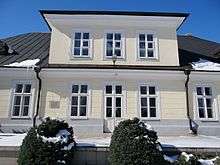
On September 3, 1939, at the very beginning of the Invasion of Poland, Sochaczew was bombed by the Luftwaffe. On September 9, first Wehrmacht units entered the town, where they remained until early September 13, when Germans were pushed out by the Polish Army, during the Battle of the Bzura. Due to German artillery fire, Poles abandoned Sochaczew on September 14–15, after a fierce and bloody battle. As a result of fighting there was widespread destruction in the town. On September 22 in the district of Boryszew, Germans shot 50 prisoners of war.
German forces remained in Sochaczew until January 17, 1945, when the town was captured by the Red Army. In the war, Sochaczew lost over 4,000 residents – 100% of its Jewish population – and 40% of its buildings were destroyed.
Notable people
- Fryderyk Chopin – composer and pianist (1810–49) born in Żelazowa Wola, gmina Sochaczew
- Bogusław Liberadzki – former Polish Minister of Transportation, MEP – born 1948 in Sochaczew
- Avrohom Bornsztain – author of the Avnei Nezer, lived there and was buried there.
- Jacek Hugo-Bader – reporter, journalist and writer.
- Ryszard Bugaj – economist and politician.
Museums
Sochaczew has three museums.
- Muzeum Ziemi Sochaczewskiej i Pola Bitwy nad Bzurą (historic museum which has militaria from the battle that was in Sochaczew by the river Bzura in 1939)
- Muzeum Kolei Wąskotorowej w Sochaczewie ("Narrow Gauge Railway Museum in Sochaczew") is a 750 mm (2 ft 5 1⁄2 in)-gauge heritage railway. It was formerly the Sochaczewska Kolej Powiatowa ("Sochaczew County Narrow Gauge Railway"). It has a fleet of historic steam, diesel and electric locomotives, goods wagons, passenger cars and draisines.
- Fryderyk Chopin's Museum and House in Żelazowa Wola
References
- The European War. World Digital Library. Accessed May 11, 2015.
External links
| Wikimedia Commons has media related to Sochaczew. |

